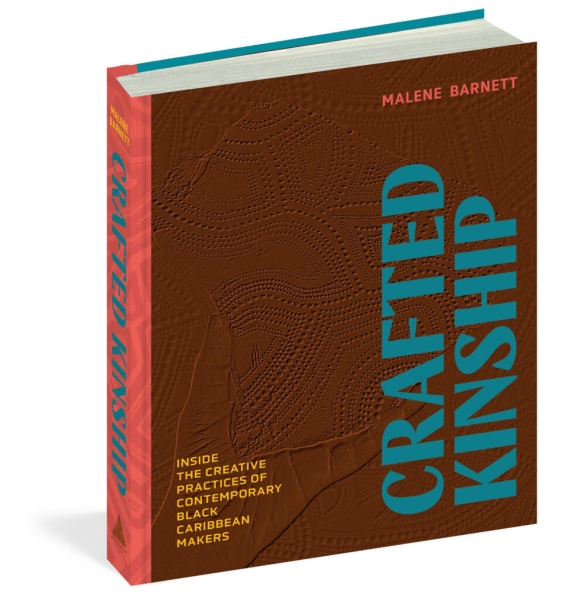Several years ago, multidisciplinary artist and Black Artists + Designers Guild founder Malene Barnett sought to examine her roots, positing questions such as: What does it mean to be a child of Caribbean immigrants? In doing so, she began piecing together narrative threads around migration, identity, materiality, African origin stories, and sustainability while studying ceramics in grad school. “I started to see repeating themes around artists in the Caribbean and in the diaspora looking at unraveling colonial histories through their creative practice,” Barnett says, noting that this furthered her curiosity. “I was looking for books focused on creative practice and process, and hearing from makers—from their perspective—versus looking at finished work… and I couldn’t find the book.”
To fill the void, Barnett created the kind of text she was seeking. The resulting book, Crafted Kinship: Inside the Creative Practice of Contemporary Black Caribbean Makers (Artisan Books; October 29, 2024), explores themes of identity and craft on a personal level, profiling 60 creatives of Caribbean heritage. “I wanted to make sure I created an archival piece, not just for my generation and current artists, but for the next generations,” she shares.
Photography courtesy of Artisan Books.
In her debut book, Barnett aims to broaden perspectives around the Black diaspora through the viewpoint of creative expression. Barnett’s narrative is guided by “threads of kinship”—or themes—and includes makers who represent a range of disciplines, from textiles to furnishings, blurring boundaries between art and design. “Because we’re in a society where the Western way of thinking about art is that you have to select a discipline, own that material, and define your practice based on that discipline, I wanted to show that from an African’s perspective, culturally, we never used those terms; we made.” she shares. “The idea of making was what was important and [making] for the purpose of creating a sustainable lifestyle—not that ‘I’m a painter,’ ‘I’m a sculptor,’ or ‘I’m a filmmaker.’”
Working on Crafted Kinship also enabled Barnett to delve deeper into her own exploration of craft. “Interviewing everybody, I learned not just about them—it also helped me in my creative process,” she says. From hair to sugar to clay, the multigenerational makers interviewed in the book offer insights into rich materiality and cultural heritage. “This is the beginning of a conversation,” Barnett asserts.
The book features largely female-identified makers, an intentional choice by Barnett to give credit where due. It’s also, fittingly, a work of design, featuring a colorful collage of images and text on every page. Each maker’s profile is aesthetically different, reflecting their varied approaches to craft and their distinct personalities. “I wanted to show the difference in diversity amongst the makers; their page is unique to them,” she adds. “It was really important for me that the makers where recording their voice from their perspective—it wasn’t about me interjecting what I thought.” As for organization, the book is arranged alphabetically by each maker’s first name in an effort to emphasize chosen names over family names, many of which have been shaped by colonization.
Spotlighted makers include Bahamian visual artist Anina Major, Haitian artist Morel Doucet, textile artist and educator of Jamaican, Trinidadian, and Bajan heritage Sonya Clark, and Jamaican multidisciplinary artist Nina Cooke John, to name a few. “I’m interested in creating archival materials that change the way Black archives look and feel and sound,” Barnett offers. Crafted Kinship does exactly that.
Editor’s note: Interested in learning more about Malene Barnett? See her work on display in Making Home—Smithsonian Design Triennial at Cooper Hewitt in Manhattan through August 10, 2025.

Malene Barnett with her first book, Crafted Kinship. Photography courtesy of Malene Barnett.

The images within Crafted Kinship reflect the diverse aesthetics of each maker. Photography courtesy of Artisan Books.

During a Fulbright trip to Jamaica in 2022, Barnett investigated clay objects made during the colonial period, which were often sold as a means for enslaved individuals to buy their freedom. Photography by Alaric S. Campbell.

